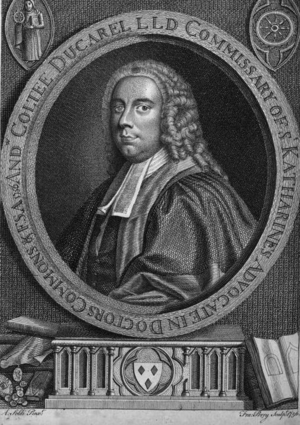Andrew Ducarel facts for kids
Andrew Coltée Ducarel (born 9 June 1713 – died 29 May 1785) was a French-English expert in old things (called an antiquary), a librarian (who manages books), and an archivist (who manages old records). He was also a lawyer who practiced civil law.
Contents
Early Life and Education
Andrew Ducarel was born in Paris, France, on 9 June 1713. His parents, Jacques Coltée Ducarel and Jeanne Crommelin, were Huguenots, which means they were French Protestants. His father was a banker and merchant.
In 1719, after his father died and because Protestants were being treated badly in France, his mother fled with Andrew and his two brothers. They first went to Amsterdam and then, in 1721, moved to England. They settled in Greenwich.
In 1728, Andrew went to Eton for school. The next year, he had a serious accident and lost one eye. He then studied at Trinity College and St John's College at Oxford University. In 1734, he and his brother became British citizens. Andrew earned his law degree in 1738 and later became a Doctor of Civil Law in 1742.
Legal and Church Work
Ducarel became a judge for church matters in 1755. He worked for the Archbishop of Canterbury, handling legal cases related to the church.
In 1756, when the Seven Years' War started, he was asked to help the High Court of Admiralty. His job was to record information about captured enemy ships.
Working with Old Books and Records
Andrew Ducarel loved history and old things. In 1737, he joined the Society of Antiquaries of London, a group for people who study the past. He also became a member of the Royal Society in 1762, which is a famous group for scientists.
In 1757, he became the keeper of the Lambeth Palace Library. This library holds many old books and important historical documents. He worked there for almost 30 years, under five different Archbishops.
Ducarel worked hard to make the library better. He created much improved lists (called catalogues) for both the printed books and the handwritten documents. He also organized all the old records of the province of Canterbury. Even though he had lost one eye and his other eye was weak, he did a lot of important work. He had some help from friends and his clerk.
He was also very interested in the old churches and buildings in the Canterbury area. With his friend Edward Rowe Mores, he wrote a history of Croydon Palace and the town of Croydon. This book was published in 1783.
In 1763, the government asked Ducarel, along with two other experts, to sort and organize important government records at Whitehall.
Exploring History
For many years, Ducarel would go on trips in August to explore different parts of the country. He traveled with his friend Samuel Gale, looking for old buildings and historical sites. They would travel about 15 miles a day and stay at inns. After dinner, Ducarel would write down all his notes about the places they visited.
In 1752, he went on a trip to Normandy, a region in France. He wrote a book called Anglo-Norman Antiquities Considered (1767), which helped many English travelers learn about Normandy. He was one of the first Englishmen to see and understand the importance of the Bayeux Tapestry, a famous embroidered cloth that tells a story from history. He included a detailed description of it in his book.
Later Life and Legacy
Andrew Ducarel was a healthy and active man. He died on 29 May 1785, at the age of 71. He was buried in the church of St Katharine's by the Tower. His wife, Sarah, lived for more than six years after he passed away.
After his death, his collections of coins, pictures, and old items were sold. His books and handwritten documents were also sold. Many of his important manuscripts went to other antiquarians who continued to study history.
Personal Life
In 1749, Ducarel married Sarah Desborough. She was a widow who was 17 years older than him and had been his housekeeper. It is said he married her out of thanks because she had taken care of him when he was very sick. They did not have any children.
Works
- A Tour through Normandy, described in a letter to a friend (London, 1754); later expanded as Anglo-Norman Antiquities considered, in a Tour through part of Normandy, illustrated with 27 copperplates (London, 1767)
- De Registris Lambethanis Dissertatiuncula (London, 1766)
- A Series of above 200 Anglo-Gallic, or Norman and Aquitain Coins of the antient Kings of England (London, 1757)
- Some Account of Browne Willis, Esq., LL.D. (London, 1760)
- A Repertory of the Endowments of Vicarages in the Diocese of Canterbury (London, 1763; 2nd edn, 1782)
- A Letter to William Watson, M.D., upon the early Cultivation of Botany in England; and some particulars about John Tradescant, gardener to Charles I (London, 1773)
- Account of William Stukeley, in vol. 2 of Stukeley's Itinerary (1776)
- A List of various Editions of the Bible, and parts thereof, in English; from the year 1526 to 1776 (London, 1776)
- Some Account of the Alien Priories, and of such lands as they are known to have possessed in England and Wales, collected by John Warburton, Somerset Herald, and Ducarel, 2 vols (London, 1779; 2nd edn 1786)
- History of the Royal Hospital and Collegiate Church of St. Katharine, near the Tower of London (1782)
- Some Account of the Town, Church, and Archiepiscopal Palace of Croydon (1783) (written with Edward Rowe Mores)
- History and Antiquities of the Archiepiscopal Palace of Lambeth (1785)
See Also
- List of Huguenots


